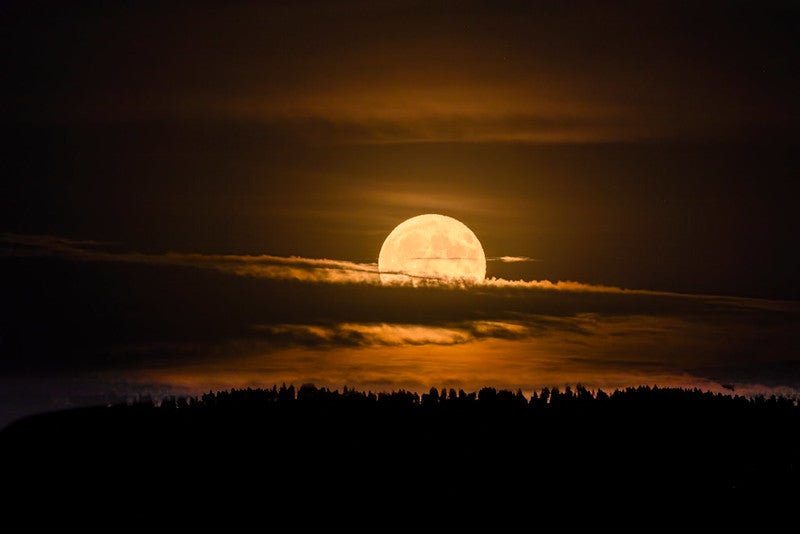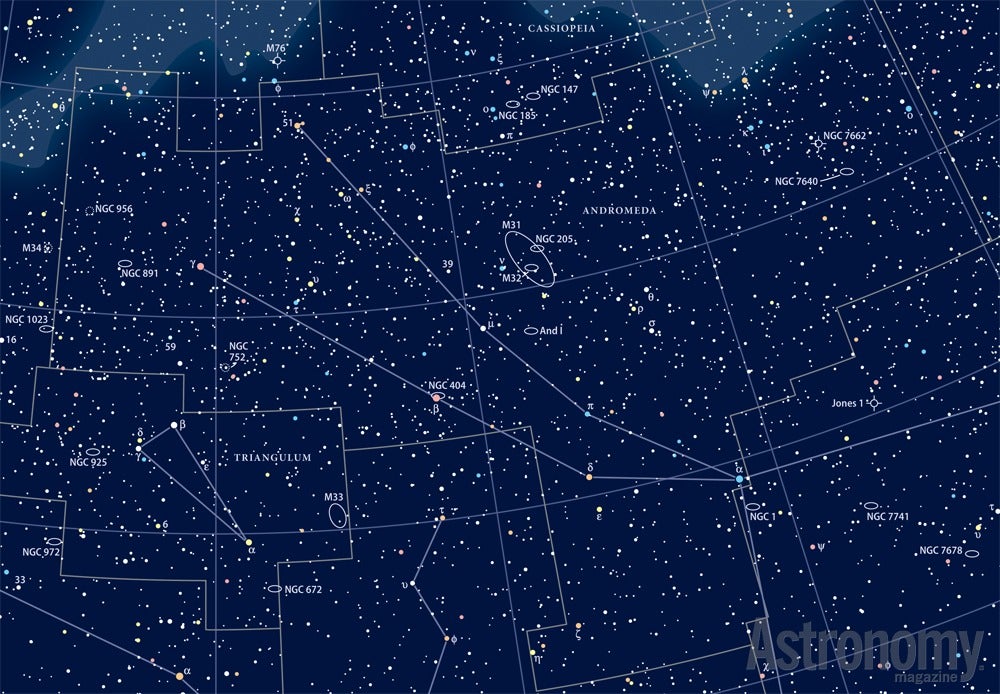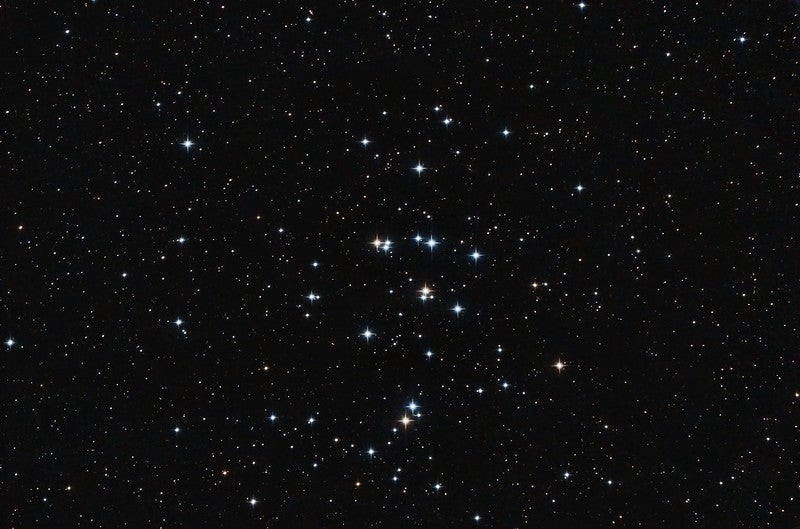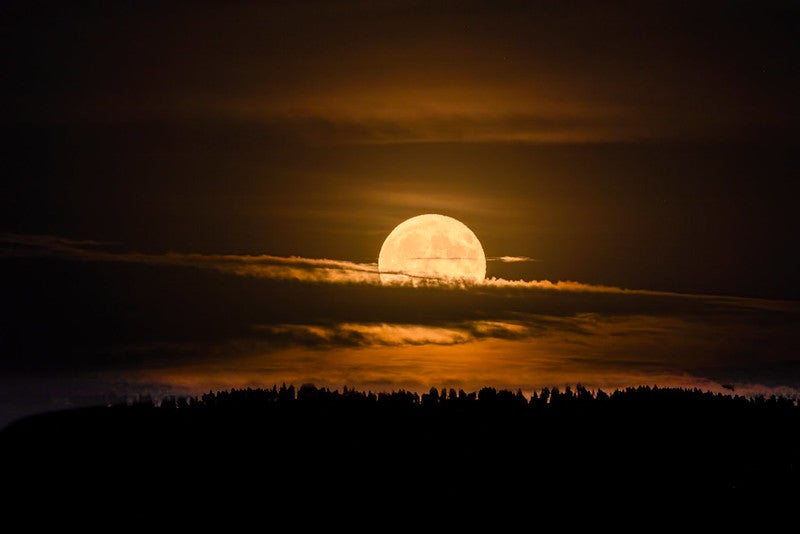
Friday, October 11
Jupiter, now located in Taurus the Bull, appears in telescopes wreathed by its four largest moons: Io, Europa, Ganymede, and Callisto. At times, those moons pass in front of or behind the planet from our point of view, and tonight you can catch the latter as Europa pops into view after crossing behind the giant world.
To locate Jupiter, look for the V-shaped constellation Taurus, rising in the east around 9 P.M. local daylight time. At magnitude –2.6, the planet far outshines any stars in this region. If you look at the gas giant with a telescope as it’s rising, you’ll spot three of its Galilean moons: Io alone to the west, with Ganymede (closer) and Callisto (farther) to the east. But that changes at 1:30 A.M. EDT (on the 12th in the Eastern and Central time zones), as Europa reappears at the northeastern limb of the planet following a nearly three-hour-long occultation and, before that, a trip through Jupiter’s long, dark shadow, which started before the planet rose across the U.S.
Throughout the early-morning hours, Europa will continue pulling away to the east, even as Ganymede is moving westward. Europa passes due north of Ganymede around 6:30 A.M. CDT, as twilight is growing across the Midwest and the East Coast is already in daylight.
The dim, distant dwarf planet Pluto is stationary at 10 P.M. EDT in the constellation Capricornus.
Sunrise: 7:07 A.M.
Sunset: 6:25 P.M.
Moonrise: 3:59 P.M.
Moonset: —
Moon Phase: Waxing gibbous (60%)
*Times for sunrise, sunset, moonrise, and moonset are given in local time from 40° N 90° W. The Moon’s illumination is given at 12 P.M. local time from the same location.

Saturday, October 12
With no Moon in the sky for several hours before dawn this morning, let’s try for one of the sky’s most distant naked-eye wonders: the Andromeda Galaxy (M31) in the constellation Andromeda. This huge spiral galaxy is larger than the Milky Way and sits some 2.5 million light-years away.
The earlier you look, the better — around 3 A.M. local daylight time, the galaxy should be roughly 60° high in the north from mid-latitudes. Glowing at magnitude 3.4, M31 is visible to the naked eye, though particularly susceptible to light pollution, so the darker your observing site, the better. Even if you can’t catch sight of it without optical aid, binoculars or any telescope will show it, some 1.5° west of magnitude 4.5 Nu (ν) Andromedae.
Note that even though the galaxy’s magnitude is brighter than the star’s, the star will be much easier to see. That’s because Nu’s light is all concentrated in a single point, while Andromeda’s is spread out over a much larger area — some 3°, the width of six Full Moons placed side by side. When looking at the galaxy through a telescope, opt for lower powers first, which will show more of the object’s extent; higher powers will reduce your field of view, also reducing the amount of M31 that will fit within it. The outer regions of the galaxy will appear fainter and more diffuse, brightening as you move inward toward its compact nucleus.
Sunrise: 7:08 A.M.
Sunset: 6:24 P.M.
Moonrise: 4:04 P.M.
Moonset: 12:57 A.M.
Moon Phase: Waxing gibbous (71%)
Sunday, October 13
Saturn is not only famous for its stunning rings, it’s also the planet in our solar system with the most moons, boasting (at last count) 146 of them! One of those moons is two-toned Iapetus, which has a light and a dark hemisphere. The moon rotates as it orbits the planet, changing brightness depending on which side is facing Earth. At eastern elongation, its darker side faces us and the moon is roughly magnitude 12. But at western elongation, its brighter side is turned earthward and the moon reaches its brightest at 10th magnitude, well within the range of medium-sized scopes.
The waxing gibbous Moon is nearing the ringed world — it will pass within 0.1° of the planet tomorrow afternoon — but if you’ve got a larger scope, let’s try for Iapetus, which reaches western elongation a full 9’ west of the planet tonight. The best time to look is between about 10 P.M. and 11 P.M. local daylight time, as that’s when Saturn stands highest in the south. It’s the brightest point of light in this region of the sky, its magnitude 0.7 glow outshining all the stars around it.
Closer to the planet, the brighter (8th-magnitude) moon Titan lies 2.5’ to the east — even if you can’t pick up 10th-magnitude Iapetus, you may still spot Titan. And if you can pick up Iapetus, look also for Tethys, Rhea, and Dione, which orbit much closer to the planet. Astrophotographers using high-speed video capture might even be able to catch a transit of Dione and, not long after, its shadow across Saturn’s southern hemisphere, starting around 11:13 P.M. EDT.
Sunrise: 7:09 A.M.
Sunset: 6:22 P.M.
Moonrise: 4:34 P.M.
Moonset: 2:02 A.M.
Moon Phase: Waxing gibbous (80%)
Monday, October 14
We’re back at Saturn this evening, as the Moon passed 0.1° north of the ringed planet at 2 P.M. EDT. By 11 P.M. EDT, that distance has widened to more than 5°, with Saturn near Lambda (λ) Aquarii and the Moon near Phi (φ) Aqr.
The pair stand highest around 11 P.M. local daylight time, when they are roughly 40° high in the south. Saturn, at magnitude 0.7, outshines even 1st-magnitude Fomalhaut in Piscis Austrinus, which sits some 21° to the planet’s south. Although the bright Moon is nearby, Saturn should still be visible in a telescope. Its rings stretch some 42”, just over twice the width of the planet’s disk, which appears 19” across.
With your naked eyes, look to the pair’s upper right and you’ll see the famous Summer Triangle asterism, now slowly setting in the west. During summertime, the Summer Triangle is high overhead around local midnight, but now that the autumnal equinox has passed, it is setting earlier each night. The Triangle is marked by three bright stars in this region of the sky: magnitude 0.8 Altair, magnitude 1.3 Deneb, and magnitude 0.0 Vega.
Sunrise: 7:10 A.M.
Sunset: 6:21 P.M.
Moonrise: 5:01 P.M.
Moonset: 3:29 A.M.
Moon Phase: Waxing gibbous (89%)
Tuesday, October 15
The gas giant Jupiter is again where the action is this morning, as its closest Galilean moon transits the disk with its shadow, while its farthest misses the planet entirely and passes due south of the massive world. If you missed out earlier this week, Jupiter is located in Taurus, high in the east in the early-morning sky and near the two stars marking the tips of the Bull’s horns. Blazing at magnitude –2.6, you definitely can’t miss it!
Io and its shadow transit first, starting with the shadow’s appearance on the cloud tops of the planet’s southeastern limb around 3:15 A.M. EDT. Io itself is still far to the planet’s east, roughly even with the shadow. Slightly closer to the planet, Callisto is also east of Jupiter, though southeast of its southern limb. At this time, the Great Red Spot is also visible on Jupiter, roughly in the center of the planet and just south of its equator. You can watch the massive storm rotate toward the western limb as the morning progresses.
Just after 4:20 A.M. EDT, when its shadow is roughly halfway across, Io finally reaches the limb and slips in front of it. The moon and its shadow cross together until about 5:25 A.M. EDT, when the shadow disappears and Io is roughly in the center of the disk. By 6:30 A.M. EDT, Io is just about to move off the western limb and Callisto is passing south of the planet’s central meridian.
If you’re more of an evening observer, the waxing gibbous Moon passes 0.6° north of Neptune at 2 P.M. EDT. By 10 P.M. EDT, the two are 5.7° apart in Pisces, which stands in the southeast. You’ll need binoculars or a telescope to spot the distant planet, which glows at magnitude 7.7 and will be quite difficult with the bright Moon nearby. However, you can use both the Moon and nearby Saturn, which our satellite passed yesterday, as markers to find Neptune — the ice giant sits about ⅓ of the way along a line drawn starting at the Moon and ending at Saturn in Aquarius.
Sunrise: 7:11 A.M.
Sunset: 6:19 P.M.
Moonrise: 5:26 P.M.
Moonset: 4:46 A.M.
Moon Phase: Waxing gibbous (95%)

Wednesday, October 16
There’s a short dark window this morning for observing if you’re up early, between when the Moon sets and morning twilight starts to brighten the sky. Let’s up our chances of a great view by seeking out a bright star cluster in the morning sky: M44, also known as the Beehive Cluster.
This young group of stars is some 720 million years old and sits less than 600 light-years away. It appears quite large in the sky, spanning some 95’ in the central regions of Cancer the Crab. At 6 A.M. local daylight time this morning, you’ll find M44 some 60° high in the southeast, to the upper right of Leo’s Sickle asterism.
Glowing at magnitude 3.7, the cluster is visible to the naked eye under good conditions and shows up well under any magnification, particularly in binoculars or small telescopes. It’s a great beginner object, offering numerous bright stars to enjoy. It’s also one of three curious naked-eye objects that appear in the Messier catalog, which was meant to prevent confusion of deep-sky objects with comets. Messier included not only the Beehive Cluster, but also the Orion Nebula and the Pleiades, none of which are likely to be easily mistaken for comets!
Asteroid 3 Juno is in conjunction with the Sun at 11 A.M. EDT.
The Moon reaches perigee, the closest point to Earth in its orbit, at 8:51 P.M. EDT, when it will stand 221,931 miles (357,163 kilometers) away. This is particularly noteworthy because Full Moon occurs in roughly 10½ hours, bringing us a Super Moon as well.
Sunrise: 7:12 A.M.
Sunset: 6:18 P.M.
Moonrise: 5:52 P.M.
Moonset: 6:03 A.M.
Moon Phase: Waxing gibbous (99%)
Thursday, October 17
Full Moon occurs at 7:26 A.M. EDT this morning, as the Moon is setting across the Midwest. You may notice that the setting Moon this morning — or the rising Moon this evening — appears particularly big and bright. That’s because October’s Full Moon — also called the Hunter’s Moon — is a Super Moon as well.
Super Moons occur when our satellite reaches its Full phase at or near perigee, the closest point to Earth in its orbit (which it reached yesterday evening.) This is 2024’s third of four Super Moons, with the preceding two in August and September and the sequence’s last during next month’s Full Moon in November. Of the four Super Moons this year, this is the largest, as the Moon is closer to Earth during this month’s Full Moon than the other three. When it reaches Full, our satellite will be some 222,056 miles (357,364 km) away. It will appear 33.44’ across in the sky, several arcminutes larger than its average of 31’.
Speaking of moons, let’s stop over again at Saturn, whose largest moon, 8th-magnitude Titan, is visible to the ringed planet’s east this evening if you’ve got a telescope. Of course, the light of our own Full Moon will wash out the sky, but magnitude 0.7 Saturn and its largest moon should still be visible through your scope. Titan is located some 2’ east of the center of the planet this evening, though it’s slowly moving westward; in two days, it will pass south of the planet and then move off to the west.
Sunrise: 7:13 A.M.
Sunset: 6:16 P.M.
Moonrise: 6:20 P.M.
Moonset: 7:23 A.M.
Moon Phase: Full
Friday, October 18
Early risers can catch Mars some 50° high in the eastern sky around 4 A.M. local daylight time. The Red planet, located in Gemini the Twins, shines at magnitude 0.2, brighter than nearby Pollux (magnitude 1.2), Gemini’s beta star. (Despite this designation, Pollux slightly outshines Castor (Alpha [α] Geminorum), which is magnitude 1.6.)
Turn your telescope on Mars to make out the Red Planet’s 8”-wide disk. For those in the Midwest, at this time the dark feature Mare Sirenum is visible on the planet’s southern hemisphere, though you’ll need a larger scope and perhaps high-speed video capture to bring it out on the relatively small disk. Mars is improving as it approaches opposition early next year, and this fall and early winter are when imagers should begin practicing on the planet to best capture features when it appears largest at opposition, when it will reach a diameter of just 15”. This isn’t particularly large, as this opposition occurs when Mars is near its aphelion — the farthest point from the Sun in its orbit, also placing it far from Earth at the same time.
While you’ve got your scope out, take a quick detour over to Castor, the higher of the two bright stars marking the Twins’ heads. This is a stunning, easy-to-split double star separated by several arcseconds. Once you’ve identified the pair, look 1.2’ to their south to see if you can spot a third star, also part of the group.
Sunrise: 7:14 A.M.
Sunset: 6:15 P.M.
Moonrise: 6:52 P.M.
Moonset: 8:43 A.M.
Moon Phase: Waning gibbous (98%)

Sky This Week is brought to you in part by Celestron.



